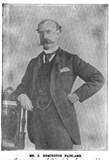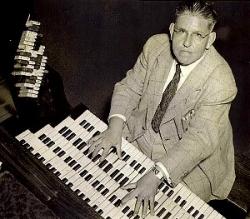Planning worship?
Check out our sister site, ZeteoSearch.org,
for 20+ additional resources related to your search.
- |
User Links
Person Results
Samuel Sebastian Wesley

1810 - 1876 Composer of "AURELIA" in Hymnal Amore Dei Samuel Sebastian Wesley (b. London, England, 1810; d. Gloucester, England, 1876) was an English organist and composer. The grandson of Charles Wesley, he was born in London, and sang in the choir of the Chapel Royal as a boy. He learned composition and organ from his father, Samuel, completed a doctorate in music at Oxford, and composed for piano, organ, and choir. He was organist at Hereford Cathedral (1832-1835), Exeter Cathedral (1835-1842), Leeds Parish Church (1842-1849), Winchester Cathedral (1849-1865), and Gloucester Cathedral (1865-1876). Wesley strove to improve the standards of church music and the status of church musicians; his observations and plans for reform were published as A Few Words on Cathedral Music and the Music System of the Church (1849). He was the musical editor of Charles Kemble's A Selection of Psalms and Hymns (1864) and of the Wellburn Appendix of Original Hymns and Tunes (1875) but is best known as the compiler of The European Psalmist (1872), in which some 130 of the 733 hymn tunes were written by him.
Bert Polman
Samuel Sebastian Wesley
David Evans
1874 - 1948 Person Name: David Evans, 1874-1948 Adapter of "NYLAND" in Singing the Living Tradition David Evans (b. Resolven, Glamorganshire, Wales, 1874; d. Rosllannerchrugog, Denbighshire, Wales, 1948) was an important leader in Welsh church music. Educated at Arnold College, Swansea, and at University College, Cardiff, he received a doctorate in music from Oxford University. His longest professional post was as professor of music at University College in Cardiff (1903-1939), where he organized a large music department. He was also a well-known and respected judge at Welsh hymn-singing festivals and a composer of many orchestral and choral works, anthems, service music, and hymn tunes.
Bert Polman
David Evans
Timothy R. Matthews

1826 - 1910 Person Name: Timothy Richard Matthews Composer of "CHENIES" in The Cyber Hymnal Timothy Richard Matthews MusB United Kingdom 1826-1910. Born at Colmworth, England, son of the Colmworth rector, he attended the Bedford and Gonville Schools and Caius College, Cambridge. In 1853 he became a private tutor to the family of Rev Lord Wriothesley Russell, a canon of St. George’s Chapel, Windsor Castle, where he studied under organist, George Elvey, subsequently a lifelong friend. He married Margaret Mary Thompson, and they had 11 children: Norton, Mary, George, Cecil, Evelyn, Eleanor, Anne, Arthur, Wilfred, Stephen, and John. Matthews served as Curate and Curate-in-Charge of St Mary’s Church, Nottingham (1853-1869). While there, he founded the Nottingham Working Men’s Institute. He became Rector at North Coates, Lincolnshire (1869-1907). He retired in 1907 to live with his eldest son, Norton, at Tetney vicarage. He edited the “North Coates supplemental tune book” and “Village organist”. An author, arranger, and editor, he composed morning and evening services, chants, and responses, earning a reputation for simple but effective hymn tunes, writing 100+. On a request he wrote six tunes for a children’s hymnal in one day. He composed a Christmas carol and a few songs. His sons, Norton, and Arthur, were also known as hymn tune composers. He died at Tetney, Lincolnshire, England.
John Perry
Timothy R. Matthews
Minot J. Savage
1841 - 1918 Author of "O star of truth, down shining" in The Beacon Hymnal Savage, Minot Judson, D.D., was born at Norridgewock, Maine, June 10, 1841, and educated at Bangor Seminary, where he graduated in 1864. From 1867 to 1873 he was a Congregational Minister, and then he joined the Unitarians, and has now (1900) a charge in Boston. He has published several works, including Poems, Boston, 1882. He also edited, with H. M. Dow, Sacred Songs for Public Worship, Boston, 1883, to which he contributed 46 original hymns. In hymnals other than this, of his hymns the following are in common use:—
1. Dost thou hear the bugle sounding. Consecration to Duty.
2. Father, we would not dare to change Thy purpose, &C. Prayer.
3. 0 God Whose law is in the sky. Consecration to Duty.
4. 0 star of truth down shining. Truth.
5. The God that to the fathers revealed His holy will. God unchangeable.
6. The very blossoms of our life. Holy Baptism.
7. What purpose burns within our hearts. Joining in Church Fellowship.
8. God of the glorious summer hours. New Year This is in D. Agate's Sunday S. Hymn Book, 1881, No. 371, and dated 1875. From the Sunny Side, N.Y.. 1875,p. 119.
Some of these hymns are given in Hunter's Hymns of Faith and Life, Glasgow, 1889, and recent American hymnals.
--John Julian, Dictionary of Hymnology, New Supplement (1907)
Minot J. Savage
J. Remington Fairlamb

1838 - 1908 Person Name: J. R. Fairlamb Composer of "MARTINEAU" in The New Hymnal for American Youth Mr. J. Remington Fairlamb received his first musical instruction at the hands of his mother. Although he was exceedingly fond of his music, while very young he was more fond of “dreaming” than of “practicing” at the piano. But at the age of twelve the boy came across a copy of Spohr’s oratorio ”The Last Judgment,” which seems to have satisfied his craving and shaped his career. When fourteen years of age he obtained a position as organist of the Western Methodist church, the first of its denomination in Philadelphia to obtain an organ. He afterwards filled the same position in the Tabernacle Baptist Church and succeeded one of the best church musicians of that city as organist and choir master of the Clinton Street Presbyterian church. During his twentieth year Mr. Fairlamb went to Europe and studied first in Paris, the piano under Marmoutel, voice under Masset, and harmony under Danhauser; subsequently he continued his studies under Mabellin in Florence Italy. Returning to America about the outbreak of the Civil War, and being incapacitated for military service by defective eyesight, Mr. Fairlamb accepted the position of Musical Director of the Church of the Epiphany in Washington, D.C. Here he enjoyed the acquaintance of many notable people, including President and Mrs. Lincoln. Being appointed United States consul at Zurich in Switzerland by Mr. Lincoln, he returned to Europe and remained there four years. His compositions number about two hundred in all. His music is distinguishable by dramatic intensity and orchestral ideas. He has published a part of a romantic opera, “Valeri,” and a quartet opera, “Love’s Stratagem.” His songs published in “St. Nicholas Songs” and “Harper’s Young People,” are so simple, quaint and delicate that, says a prominent New York contralto, he would live had he composed nothing else, forever in these.” His “Cradle Song” is a worthy specimen of this style of composition. Mr. Fairlamb has charge of societies in Newburgh, Hudson and Catskill.
from The World's Best Music: Famous Songs and Those who Made Them Famous, Volume 1
By Frederic Dean, Reginald De Koven, Gerrit Smith
J. Remington Fairlamb
Clarence Kohlmann

1891 - 1944 Composer of "[O star of truth now shining]" in Hymns We Love Born: September 24, 1891, Philadelphia, Pennsylvania.
Died: December 13, 1944, Philadelphia, Pennsylvania.
Buried: Greenwood Cemetery, Philadelphia, Pennsylvania.
An organist and composer, Kohlmann wrote for the organ, piano, and hand bells. In 1929, he recorded four organ works, including The Storm, for inventor Thomas Edison. He was also a fixture at the Great Auditorium in Ocean Grove, New Jersey, where he played the organ for the last two decades of his life.
--www.hymntime.com/tch/
Clarence Kohlmann
Alexander Gibson
Person Name: Alexander S. Gibson Composer of "ALEXANDER" in Hymns for Creative Living
Alexander Gibson


 My Starred Hymns
My Starred Hymns

